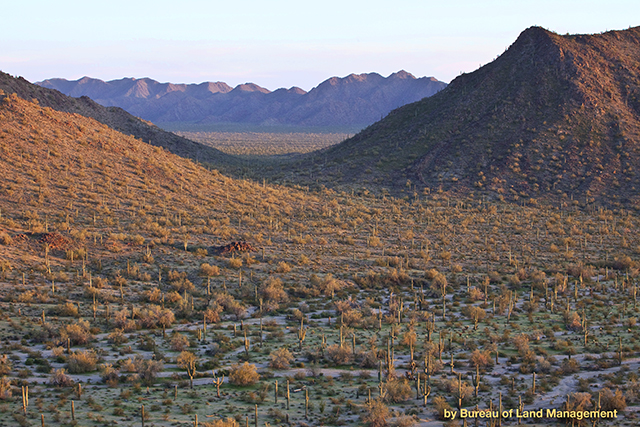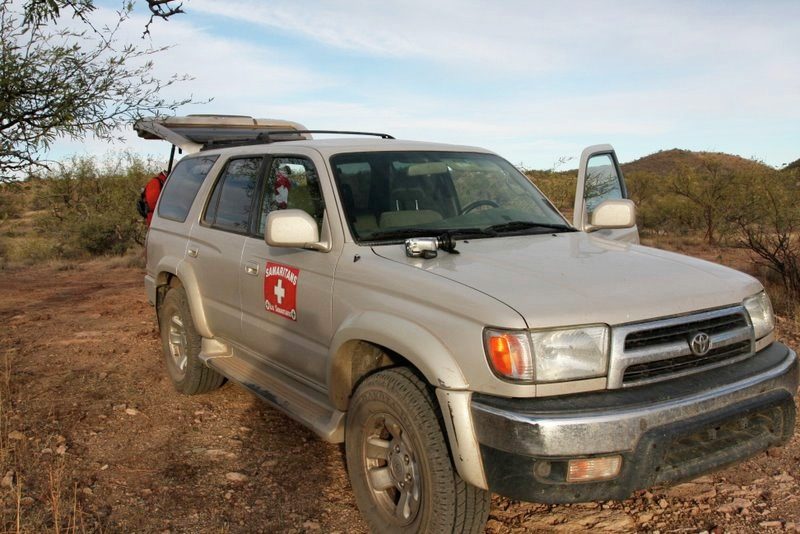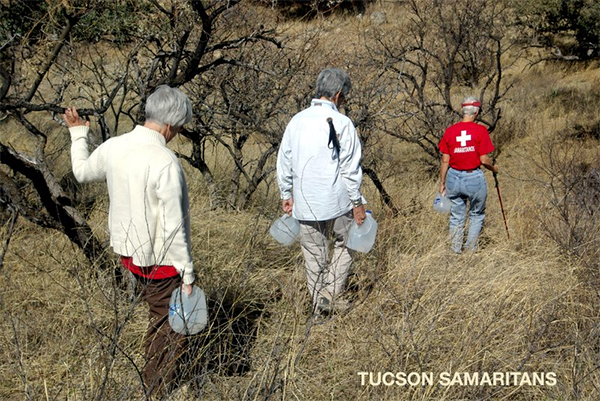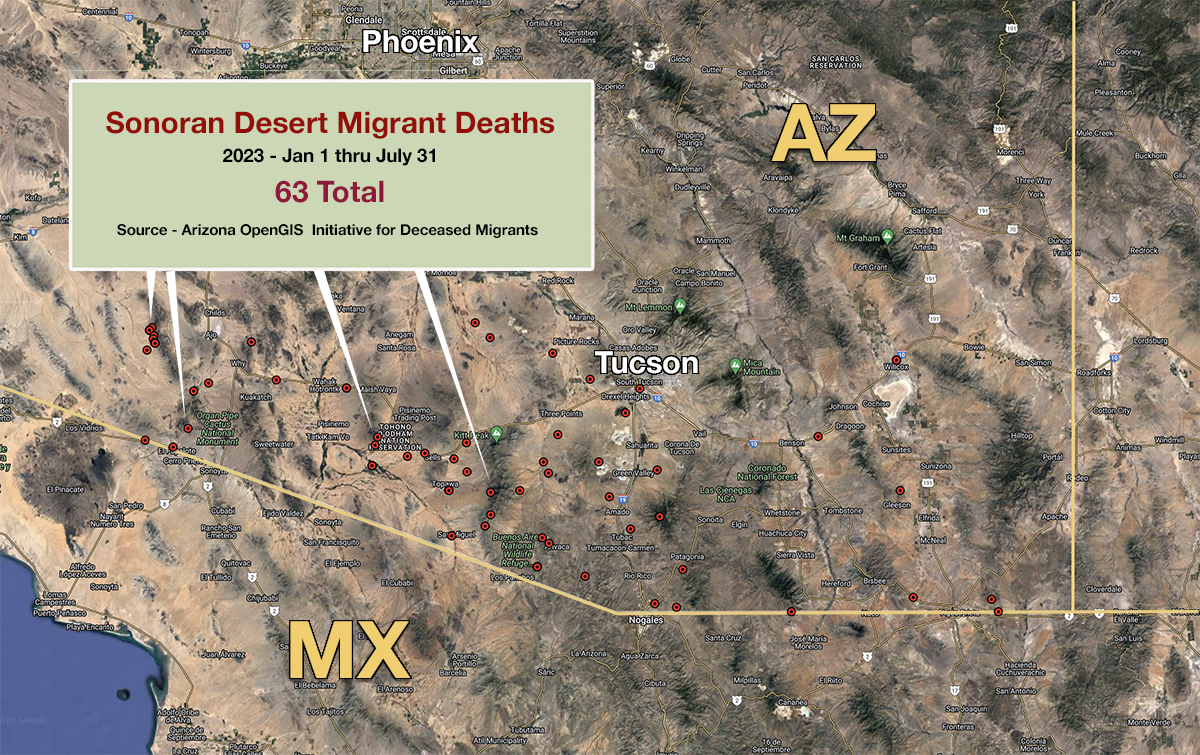 by Carol Trible
by Carol Trible
A lot of people know the Arizona desert can be deadly in the summer but may not know that it can also be deadly in the winter. Because southern Arizona is a desert, with very low humidity, even breathing can dehydrate you. The low humidity and normally cloudless skies mean that there can be up to a 50º temperature difference between day and night, so hypothermia is also a danger, especially in the higher elevations where it is colder.
In the 1990’s the Border policy changed to “Prevention through Deterrence”, see Prevention Through Deterrence. This policy change meant that those desperate enough to cross the border could no longer do so at or near the border crossing cities. Instead, they were forced into more deadly areas. Unfortunately, this official US policy has not stopped people from crossing, but instead forced them into more deadly areas, where many die each year.
In Southern Arizona there are a number of different organizations that try to help these people, some of them are : Humane Borders – with large water tanks marked with flags, where crossers can get clean water; Samaritan Patrol, the organization I belong to that does a number of different things, including hiking into the desert to put out food, water, and blankets. Another group, No More Deaths, does some of the same things as Samaritan patrol, in addition to maintaining a camp in the desert to assist folks and give them a chance to rest.
I joined SAM’s (what we tend to call the group) shortly after it was created over 20 years ago, first at most once a month (working full time got in the way ) then almost every week once I retired (until the pandemic). I am still working on getting back in the grove on that now mostly as part of the self-named water buffalo group. I liked doing that one over the other types of hikes, because even if we didn’t see anyone, we saw evidence through water use, that we were helping people. At 60 I was normally the youngest person on our trips, now in my 70s, I occasionally still am.
A water buffalo SAM trip starts at 6 or 7 AM - depending on the time of year. We meet at the shed, normally 3 or 4 people, but sometimes only 2. The shed is where SAM’s (Samaritan Patrol) vehicles are stored. We load the vehicle with food and water from the shed, make sure we have the logbook (to track what we find at the water drops), SPOT, signs and GPS’s.
 Side note – our vehicles now have names – starting with Joe – named for Joe Arpaio – because a group that sued him and Maricopa County for his harassment won, and bought Joe (then a brand-new SUV) for us with part of the monetary judgement – Joe has since been retired, but we now have Samantha Jean and Ed, both named after dedicated volunteers.
Side note – our vehicles now have names – starting with Joe – named for Joe Arpaio – because a group that sued him and Maricopa County for his harassment won, and bought Joe (then a brand-new SUV) for us with part of the monetary judgement – Joe has since been retired, but we now have Samantha Jean and Ed, both named after dedicated volunteers.
We first head to the freeway, then south, getting off at Amado, heading towards Arivaca. First stop/slowdown is the Border Patrol checkpoint, heading in we don’t have to stop, but there are some substantial speed bumps, so we aren’t going fast. Everyone who lives in Arivaca must go over these when returning home from any place large enough to have anything besides small shops and businesses. Normally shortly after that we pull over to put the magnetic signs on the side of the vehicle that identify us as Samaritans – some of the “travelers” (the term we now use for the border crossers) know to look for our vehicles if they need help.
 When we get to our first water drop on the day’s route, we load up with water and food, and head down/up the trail. A gallon of water weighs 8 pounds. I am trying to build back up to carrying three gallons but I am still at two gallons. Some of the hikes are relatively short, and even over moderately flat terrain, some are up and down, and at least one seems to go straight up. The longest ones are about ¾ mile one way. We hit anywhere from 4 to 7 drops in a normal day.
When we get to our first water drop on the day’s route, we load up with water and food, and head down/up the trail. A gallon of water weighs 8 pounds. I am trying to build back up to carrying three gallons but I am still at two gallons. Some of the hikes are relatively short, and even over moderately flat terrain, some are up and down, and at least one seems to go straight up. The longest ones are about ¾ mile one way. We hit anywhere from 4 to 7 drops in a normal day.
We hike to the drop(s) – sometimes several on one route, check the usage, add water and food if needed, and carry out any trash with us. We track the water bottle use, note what kind it is by people, natural damage (chewed by animals, pecked on by birds, stomped on by cattle, or split from freezing) or vandalized (usually shot or slashed, occasionally opened and emptied, but we it’s hard to tellthe latter unless folks videoed themselves and posted on social media). The usage information helps us decide how often to check drops, and to know if it is time to stop a drop and find another that is along a more used route.
We rarely actually see any travelers but when we do, we check with them to see how they are doing, the choice to call Border patrol is always theirs. Most of the time, if we see someone, they are done, they are not able/willing to go on. In any case we offer them food and water, and if they want us to call Border patrol, we do that, and wait with them (or leave someone with them if we must drive to get a signal, then return) until Border Patrol (BP) arrives. If we see BP with people, we stop, and offer food and water, usually BP says no, that they have what is needed, but sometimes they do accept it.
When we are done with the day, we head back to the shed, sometimes with a stop at a local watering hole for a snack or drink, and to see if anything is going on locally. We unpack, put everything we didn’t use back in the shed, usually wind up distributing the garbage for folks to dispose of at home, and head home. Someone in the group will write up a report of what we did for the day, water dropped, BP or traveler encounters, etc.and email it to the group, sometimes with bird and animal sightings included also.
And then go home and take a shower...
